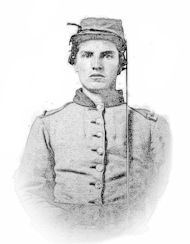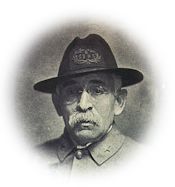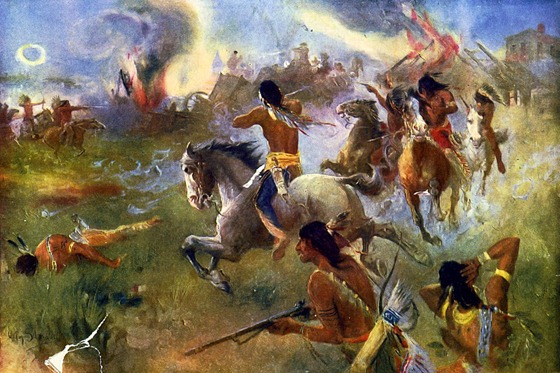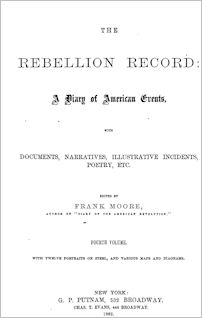Sunday, 24th.—Arrived at Roger’s Gap, twenty miles south of Cumberland, at 11 A. M. Crossing the mountain. So steep had to pull wagons and artillery up by hand; got to the top about 2 P. M.; rested a few minutes, and then moved forward. They called this a gap, but I was unable to see much gap
Thursday, August 23, 2012
Saturday 23d.—Relieved by Hilliard’s Legion. Started down Powell’s Valley at 6 p. M. Marched all night.
August 23—Went uptown to see my brother, Morris, of the 44th Georgia Regiment; but his regiment had already gone to Gordonsville, so I returned to camp.
AUGUST 23D.—Members of Congress are coming to my office every day, getting passports for their constituents. Those I have seen (Senator Brown, of Mississippi, among the rest) express a purpose not to renew the act, to expire on the 18th September, authorizing martial law.
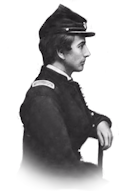
“There is no town proper here, nothing but a lot of little wretched shops about the wharves, but the sea view is superb.” –Diary of Josiah Marshall Favill
August 23d. Up early and made a prompt start; half an hour afterwards it began to rain and soon poured down in torrents. We know a thing or two now about campaigning, and so a rain storm is something to enjoy, at least for mounted men; on the pommels of our saddles we carry, rolled and strapped, a rubber coat, leggings, and cap cover, and on the first appearance of rain get into our leggings, strapping our spurs over them, so that the feet are protected. The coat is made on purpose for mounted men and is full behind to cover the horse and blankets. When one is encased in this rubber armor, he can laugh at the wildest storm, perform his duties comfortably, and go into his quarters perfectly dry. The men are provided with ponchos, a rubber blanket with a slit in the center, through which the head is passed, and thus are fully protected, as also are their arms and accoutrements; marched steadily without interruption, arriving at noon, and encamped by the sea side,
“Where we long have pined to
Linger, where the pebble-covered shore,
Under the quiet faint kisses of the sea,
Trembles, and sparkles as with ecstacy.”
The rain ceased before we arrived, and the sun shone just as brilliantly as ever, and soon dried up the ground. There is no town proper here, nothing but a lot of little wretched shops about the wharves, but the sea view is superb. The water so deep that the largest ships can come close to the shore; all the natural elements, in fact, for a great seaport, but there is no enterprise in this part of the country; everything seems to have long since attained its maximum, and is now content to vegetate and gradually die. Our men bought out the oyster men in short order, and were soon engaged in frying, stewing, and eating raw, every variety of oyster under the sun. A small party from our headquarters took a swim in the deep blue sea during the evening and greatly enjoyed it.
On August 18, 1862, a Union recruiting party was ambushed by Sioux warriors not long after leaving New Ulm. Survivors rushed back to warn the town. The town was attacked the next day, with warriors firing from a bluff above. A second attack occurred on August 23, when New Ulm was completely encircled by the attacking Indians.
_____________________
Battle between Sioux Indians and settlers in August 1862.
The siege of New Ulm, Minn, painted by H. Aug. Schwabe about 1902. Library of Congress image.
____________________
Battles of New Ulm (from Wikipedia)
The Battles of New Ulm were two battles in the Dakota War of 1862 in August. The settlement of New Ulm, Minnesota had 900 settlers around the time and was the largest settlement near the Sioux reservation. After the Battle of Fort Ridgely, the town was seen as a tempting target for a Sioux attack. The topography of the town also presented an advantage for the Sioux, since the land rises some 200 feet out of the Minnesota River valley in two large steps, with wooded area to provide cover for an attack.
On August 18, 1862, a recruiting party for Civil War volunteers left New Ulm, but was ambushed in Milford Township. The survivors raced back to town and warned the settlers of an impending attack. The townspeople prepared for the attack by erecting barricades on the streets and packing the women and children into any available brick buildings. The first attack came on August 19, with about 100 Sioux warriors firing on the city from the bluff behind the town. A small number of civilians returned the fire as best as they could. Later in the day, a thunderstorm discouraged the Indians from continuing their attack, and there were no chiefs present to give orders. The first battle ended with six settlers killed and five wounded.
After the first attack, Charles Eugene Flandrau reached the city as part of a detachment from St. Peter and Le Sueur. Dr. Asa W. Daniels, Dr. Otis Ayer, and Dr. William Worrall Mayo (father of William James Mayo and Charles Horace Mayo) were also part of this group. Dr. Mayo and Dr. William R. McMahan of Mankato set up a hospital in the Dacotah House and Drs. Ayer and Daniels set up a hospital in a store across the street. This undoubtedly helped in the treatment of the wounded.
Flandrau’s forces were bolstered by about a hundred men from Mankato, two companies from Le Sueur, and militias from Brown County, Nicollet County, St. Peter, Lafayette, and New Ulm. In all, Flandrau had about three hundred citizen-soldiers under his command, but most were poorly armed. Meanwhile, more than a thousand settlers were barricaded on New Ulm’s main street. On Saturday, August 23, around 9:30 in the morning, the Sioux began their second attack on the city. The Sioux were superior in numbers, and were able to encircle the entire town. The defenders of New Ulm set many buildings on fire in an attempt to create an open space without cover. Captain William B. Dodd, second in command, was killed while leading soldiers beyond one of the barricades of the city. After nightfall, Flandrau ordered that the rest of the buildings outside of the barricades to be burned. In all, 190 structures within the city were destroyed. The next morning, August 24, the Indians reappeared, fired some harmless long-range shots, and then withdrew. Flandrau convened with his officers later that day and decided to evacuate the city, due to a shortage of ammunition and food and epidemics of disease. The following morning, August 25, 2000 people, including 153 wagons and a large number of refugees, left the city and headed to Mankato, about 30 miles to the east. The procession was escorted by about 150 troops and made it through to Mankato safely.
August 23.—The United States steam sloop-of-war Adirondack struck on a coral reef near Little Abaco, W. I., and was lost. The crew were saved. —The Eighteenth regiment of Connecticut volunteers, under the command of Col. Wm. S. Ely; the One Hundred and Eleventh regiment, New York State volunteers, Colonel Jesse Segoine, and the Thirty-fifth Massachusetts, commanded by Col. Edward A. Wild, passed through New York City, en route for the scat of war.
—The schooner Louisa, while attempting to run the blockade of Charleston, S. C, was captured by the United States steamer Bienville.—A train of cars on the Memphis and Charleston Railroad, when three miles beyond Courtland, Tenn., was attacked by guerrillas numbering four hundred, who destroyed the train, which was in charge of a detachment of the Forty-second Illinois regiment. Eight rebels were killed. The Federal loss was two wounded and two missing.—This afternoon a mutiny broke out among the soldiers belonging to Spinola’s Empire brigade, at their encampment, East New-York. One man was shot and a number seriously injured. An attack was made upon the Howard House by the mutineers, who subsequently fled to Brooklyn and New York. The police was called out, and succeeded in quelling the riot. A squad of United States marines was put on guard, and order was restored. —A Passenger train on the Winchester (Va.) Railroad, when between that place and Harper’s Ferry, was fired into and stopped by a party of rebel guerrillas. The passengers were released, except four soldiers of the First Michigan, who were made prisoners. The train and its contents were completely destroyed.
—The battle on the Rappahannock between the armies under Gen. Pope and Gen. Lee, was resumed at an early hour this morning by a cannonade all along the opposing lines, which lasted for several hours. In consequence of the swollen state of the Rappahannock, the railroad bridge was in great danger of being carried away, and the advanced column of the Union army was therefore removed from the left to the right bank of the river, and the bridge was destroyed. New positions were taken, from which the old ones could be enfiladed, and on the rebels appearing in strong force for the purpose of occupying the abandoned position, a terrific cannonade was opened upon them, which drove them back into the woods with great loss. In the afternoon a portion of the rebel army succeeded in crossing the Rappahannock River, in the vicinity of Sulphur Springs, and a sharp engagement took place between them and Gen. Milroy’s brigade, the advance of Gen. Sigel’s corps, which resulted in the rebels being driven across Great Run, suffering great loss. In consequence of the success of the rebels in throwing a part of their forces across the Rappahannock, General Pope advanced his whole army from his position in the vicinity of Rappahannock Station to Warrenton and Sulphur Springs.— (Doc. 104.)
—A skirmish occurred near Big Hill, Madison County, Ky., between the Union troops under General Metcalfe and a superior force of rebels, resulting in the retreat of the Nationals to Richmond, Ky.—(Doc. 190.)
